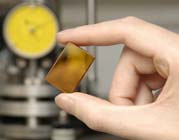
Though every month we read about some new advance in artificial intelligence, how much progress is really being made? Neuromorphic computing has created software and electronic hardware that mimic brain functions and signal protocols but, like economic models that successfully predict the past, they have only slightly improved the efficiency and adaptability of conventional technology and are not really making bold advances.
Compared to our biological systems, today's computers still can't think after 70 years of promise, and they are still more than a million times less efficient. Simulating five seconds of brain activity on a computer takes 500 seconds and needs 1.4 MW of power, compared to a tiny number of calories burned by the human brain.
Perhaps closing the gap does not require some unknown future science, it could be brought about by technology that has been common since the 1980s - optical fibers. Optical fibers made of specialty glass - chalcogenide (glasses based on sulfur) that possess a variety of broadband photo-induced effects - allow the fibers to be switched on and off to process huge amounts of data in a much more energy-efficient manner.
Professor Dan Hewak from the Optoelectronics Research Centre (ORC) at the University of Southampton, says, "Since the dawn of the computer age, scientists have sought ways to mimic the behavior of the human brain, replacing neurons and our nervous system with electronic switches and memory. Now instead of electrons, light and optical fibers also show promise in achieving a brain-like computer. The cognitive functionality of central neurons underlies the adaptable nature and information processing capability of our brains."
Co-author Dr. Behrad Gholipour explains, "By going back to biological systems for inspiration and using mass-manufacturable photonic platforms, such as chalcogenide fibres, we can start to improve the speed and efficiency of conventional computing architectures, while introducing adaptability and learning into the next generation of devices."
By exploiting the material properties of the chalcogenides fibres, the team led by Professor Cesare Soci at Nanyang Technological University have demonstrated a range of optical equivalents of brain functions. These include holding a neural resting state and simulating the changes in electrical activity in a nerve cell as it is stimulated. In the proposed optical version of this brain function, the changing properties of the glass act as the varying electrical activity in a nerve cell, and light provides the stimulus to change these properties. This enables switching of a light signal, which is the equivalent to a nerve cell firing.
The research paves the way for scalable brain-like computing systems that enable 'photonic neurons' with ultrafast signal transmission speeds, higher bandwidth and lower power consumption than their biological and electronic counterparts.
Soci said, "This work implies that 'cognitive' photonic devices and networks can be effectively used to develop non-Boolean computing and decision-making paradigms that mimic brain functionalities and signal protocols, to overcome bandwidth and power bottlenecks of traditional data processing."
Published in Advanced Optical Materials. The project is funded by Singapore's Agency for Science, Technology and Research (A*STAR) Advanced Optics in Engineering program and conducted within The Photonics Institute (TPI), a recently established dual institute between NTU and the ORC.





Comments